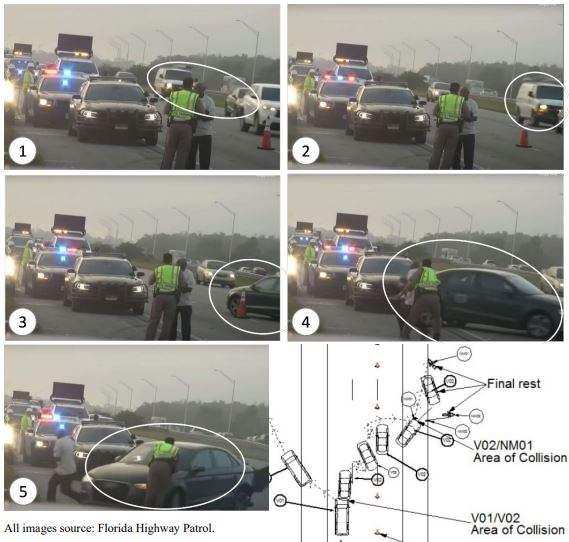Firetruck Accident Statistics
"Emergency responders are trained to be extremely careful and vigilant in transport and when responding to roadside incidents... Despite these precautions, however, the rate of these collisions in recent decades has remained relatively unchanged, with fatal consequences."
For 2023, NFPA estimates that 19,225 fire department vehicles were involved in traffic accidents which resulted in 1,450 firefighter injuries. 24 At accident scenes, emergency responders are at risk of secondary collisions (errant drivers hitting, clipping, or colliding with them).
In 2024, errant vehicles struck and killed 46 emergency responders working at various types of roadway incidents (including Law Enforcement Officers, Fire/EMS, Tow Operators, Road Service Technicians, and DOT Safety Patrol personnel). 21 Motor vehicle crashes are the second-leading cause of death for on-duty firefighters. 8
"Protect their lives so they're there to save yours."
Traffic accidents involving firetrucks can occur while driving to an incident, parked at a roadside accident scene, or returning from an incident. At the scene of roadside accidents, firetrucks block highway lanes to increase safety for emergency responders.
“71% of U.S. drivers take photos or videos when they see an emergency vehicle on the side of the road... Worse still, 16 percent – more than 1 in 10 – said they either have struck or nearly struck a first responder or emergency vehicle stopped on or near the road.”
Departments often park firetrucks diagonally at roadway accidents to block traffic and protect emergency responders. In 2022, an estimated 2,800 to 3,000 firetrucks were struck while blocking (14-15% of all firetruck collisions are estimated to occur while blocking near recent/previous crash scenes or while stopped in the roadway). 6
Secondary collisions account for an estimated 15% of all reported crashes & result in 18% of all traffic fatalities nationwide. 12, 26 35 Secondary collisions also account for 25% of all traffic delays (and can result in extended operations and traffic exposure for emergency responders). 26 35 Electric vehicle and other modern vehicle fires can also result in extended operations (and extended traffic exposure) for firefighters. 29, 30 One study found that 50% of secondary collisions involved an SUV while 30% involved a passenger vehicle (where the secondary collision followed an initial traffic barrier impact). 27
Secondary collisions between live traffic and firetrucks used as blockers often cause significant damage requiring costly repairs and lengthy time out-of-service for repairs. 17, 18, 19, 28 In 2025, the price of pumper and tanker firetrucks have exceeded $1 million and the price of ladder fire trucks have exceeded $2 million with some departments reporting 4 year lead times for new trucks. 25, 31, 32 The cost of all emergency vehicle crashes (including fire, police, and ambulance) in the U.S. is estimated to be as much as $35 billion annually. 7
Using firetrucks to block lanes is often suboptimal & may present additional hazards in some situations (i.e. underride hazard to motorists, snag points & pocketing hazard to motorists, rapid deceleration hazard to motorists, debris/shrapnel hazard, firetruck roll-forward/skid-forward hazard if insufficiently weighted, and firetruck rollover hazard due to high center of gravity). 15, 16, 22, 23 In addition, maintaining older fire trucks to block lanes can be expensive. 20 In 2025, several departments have reported shortages of specialized fire mechanics and significant maintenance/repair delays for specialized fire trucks which has strained fleets. 33, 34
“More and more fire departments are adding blocking units to protect emergency scenes... [Blocking units] are design[ed] to take the impact of a vehicle, maintaining the integrity of the emergency scene even in case of a secondary crash."
“'[A] fire truck is custom built from the ground up for the explicit purpose of fighting fires.' This means not only are the engines themselves more expensive, but repairing them can be a more specialized job...a lot of 'OEM' parts for an older fire engine are simply too rare to be feasible."
“Over a five-year period, nine Irving [fire] apparatus were struck while blocking at roadway incidents. Two of those [firetruck] vehicles, including Ladder 52, were totaled. The total time out of service for all the damaged apparatus was 2,018 days (more than 5.5 years), which forced the department to operate with reserve equipment."
“In the neighboring city, Dallas Fire Rescue (DFR) implemented the blocker program after determining that fire apparatus were struck 62 times over a three-year period.”
"An average of 12,200 roadway responses occur every day in the United States, where responders are under the threat of everyday drivers hitting, clipping, or colliding with them as they drive by."
"Our emergency responders deserve the highest levels of protection as they grapple with situations that are not only tactically difficult but also emotionally taxing."
Estimated Firetruck Collisions & Injuries (1990-2023)
1, 2, 3, 4, 5, 9, 24
Emergency Responder Struck-By-Vehicle Fatalities
(2019-2024)
21
 Secondary Crash Example: The white van rear-ended the black car while passing a primary crash scene (image 1 & 2, above). The black car spun laterally across 1 lane in 0.7 seconds, striking a cone (image 2 & 3). Within another 1.3 seconds, the black car spun laterally across another 1.5 lanes and struck a pedestrian police officer (image 4 & 5). Source: FHWA Report No. FHWA-HOP-23-043, pp. 41, Youtube Footage: Associatied Press "Camera captures car hitting Florida Trooper".
Secondary Crash Example: The white van rear-ended the black car while passing a primary crash scene (image 1 & 2, above). The black car spun laterally across 1 lane in 0.7 seconds, striking a cone (image 2 & 3). Within another 1.3 seconds, the black car spun laterally across another 1.5 lanes and struck a pedestrian police officer (image 4 & 5). Source: FHWA Report No. FHWA-HOP-23-043, pp. 41, Youtube Footage: Associatied Press "Camera captures car hitting Florida Trooper".
